Spatial and Temporal Changes in Ecological Resilience in the Shanxi–Shaanxi–Inner Mongolia Energy Zone with Multi-Scenario Simulation
Abstract
1. Introduction
2. Research Framework
2.1. Conceptual Framework for Ecological Resilience Evaluation in the SEZ
2.2. Framework for the Selection of Indices
3. Materials and Methods
3.1. Study Area
3.2. Data Sources
- Land-use data. The land-use data were obtained from the Resource and Environment Science Data Center of the Chinese Academy of Sciences (CAS). According to the classification rules formulated by the CAS [47], land use was classified into six types: cultivated land, woodland, grassland, water body, construction land, and unused land;
- Driving factor data. When using the PLUS model for multi-scenario simulations, driving factors must be produced, including environmental factors and socio-economic factors. In addition to those shown in Table 1, the distance to the county (district, banner) administrative center and individual road levels were calculated using the ArcGIS 10.3 Euclidean distance tool;
- Other socio-economic data. Grain sowing area and production data in the SEZ were obtained from the 2001–2021 Statistical Yearbooks of each county and district. Grain prices were obtained from the “National Compendium of Agricultural Product Costs and Benefits”. Energy development enterprises in the SEZ were selected from the 2020 list of key pollutant discharge units by the ecological environment bureaus of each county (district, banner), and the coordinate information was obtained from the Baidu coordinate picking platform and transformed into WGS84 coordinates.
3.3. Methodology for the Calculation of Indices
3.3.1. The Resistance Index
3.3.2. The Adaptability Index
3.3.3. The Recovery Index
3.3.4. The Resilience Index
3.4. Spatial Autocorrelation Model
3.5. Land-Use Change Simulation Based on the PLUS Model
3.5.1. PLUS Model
3.5.2. Multi-Scenario Settings
- BAU scenario: Based on the actual development of the SEZ, according to the land-use change trend from 2010 to 2020, the area of each land-use type in 2030 was calculated using a Markov chain, which is the original 2030 prediction result generated by the PLUS model;
- EMD scenario: Since the implementation of the Western Development Strategy in 2000, the large-scale development of energy and mineral resources and the construction of supporting facilities in the SEZ have led to an accumulation of waste soil and slag, which has blocked rivers. In addition, coal mining has damaged the natural ecosystem structure and changed landscape patterns and geomorphology. Accordingly, this study identified a 50% increase in the probability of conversion of cultivated land, woodland, grassland, and water bodies to unused land. Additionally, a 30% increase in the probability of conversion of cultivated land, woodland, grassland, and water bodies to construction land was determined. Moreover, there was a 30% decrease in the probability of conversion of construction and unused land to cultivated land, woodland, grassland, and water bodies, and a 20% increase in the probability of conversion of construction land to unused land.
- ECR scenario: Under the promotion of a series of ecological restoration projects, such as returning farmland to woodland (grassland), the area of regional soil erosion has been significantly reduced, and the ecological construction results were remarkable. Therefore, this study designated the water system and nature reserve within the SEZ as a restricted development area. Simultaneously, it strictly limited the transfer of woodland, grassland, and water bodies, reducing the probability of conversion to construction and unused land by 50%. It also aimed to decrease the probability of cultivated land being converted to construction and unused land by 30% and increase the probability of unused and construction land being converted to woodland, grassland, and water bodies by 30%.
4. Results
4.1. Land-Use Change Characteristics
4.2. Ecological Resilience Spatial and Temporal Patterns
4.3. Spatial Relationship between Ecological Resilience and Energy Development
4.4. Multi-Scenario Simulation
4.4.1. Land Use under Different Scenarios
4.4.2. Ecological Resilience under Different Scenarios
- BAU scenario. The proportions of low, medium, and high ecological resilience under the BAU scenario are 40.2%, 44.7%, and 15.1%, respectively. Among them, the proportion of low-level resilience increases by 1.8% compared to that of the actual situation in 2020, indicating that if not restricted, the SEZ’s ecological resilience will decrease further. The areas with high ecological resilience and resistance are located in the Yellow River Basin in the northern part of the SEZ, and the low-value adaptability area is located in the woodlands of the eastern part of Xing County in Shanxi Province. The high-value recovery areas are located in the western part of Yuyang District, Shaanxi Province, where unused land predominates, with less anthropogenic-dominated construction land, and a better recovery capacity;
- EMD scenario. The proportions of low, medium, and high ecological resilience are 44.3%, 42.6%, and 13.1%, respectively. Ecological resilience is low in Shenmu City, located in the central part of the SEZ, and Hengshan County, in the southern part of the SEZ. The overall low level of ecological adaptability in the SEZ may be explained by the significant growth of construction land area under this scenario, resulting in landscape fragmentation and reduced landscape connectivity;
- ECR scenario. The proportions of low, medium, and high ecological resilience are 37.5%, 46.4%, and 16.1%, respectively. Areas with high ecological resilience and resistance are mostly concentrated in the Yellow River Basin and the eastern part of Xing County, Shanxi Province. In addition, the overall ecological adaptability is high, indicating that under the ECR scenario, the SEZ emphasizes ecological land protection, reduces construction land encroachment on ecological land, and reduces landscape fragmentation. This will increase landscape heterogeneity and connectivity, and there will be a high level of ecological resilience in the future.
5. Discussion
5.1. Expansion Trend of Construction Land in the SEZ
5.2. Comparison of Multi-Scenario Ecological Resilience Simulation Results
5.3. Research Insights
5.4. Shortcomings and Prospects
6. Conclusions
Author Contributions
Funding
Data Availability Statement
Conflicts of Interest
References
- Zhang, H.L.; Shen, L.; Zhong, S.; Elshkaki, A. Coal resource and industrial structure nexus in energy-rich area: The case of the contiguous area of Shanxi and Shaanxi Provinces, and Inner Mongolia Autonomous Region of China. Resour. Policy 2020, 66, 101646. [Google Scholar] [CrossRef]
- Zhang, M.; Wang, J.; Li, S. Tempo-spatial changes and main anthropogenic influence factors of vegetation fractional coverage in a large-scale opencast coal mine area from 1992 to 2015. J. Clean. Prod. 2019, 232, 940–952. [Google Scholar] [CrossRef]
- Aizizi, Y.; Kasimu, A.; Liang, H.; Zhang, X.; Zhao, Y.; Wei, B. Evaluation of ecological space and ecological quality changes in urban agglomeration on the northern slope of the Tianshan Mountains. Ecol. Indic. 2023, 146, 109896. [Google Scholar] [CrossRef]
- Holling, C.S. Resilience and Stability of Ecological Systems. Annu. Rev. Ecol. Syst. 1973, 4, 1–23. [Google Scholar] [CrossRef]
- Delettre, O. Identity of ecological systems and the meaning of resilience. J. Ecol. 2021, 109, 3147–3156. [Google Scholar] [CrossRef]
- Folke, C. Resilience: The emergence of a perspective for social-ecological systems analyses. Glob. Environ. Chang. Hum. Policy Dimens. 2006, 16, 253–267. [Google Scholar] [CrossRef]
- Quinlan, A.E.; Berbes-Blazquez, M.; Haider, L.J.; Peterson, G.D. Measuring and assessing resilience: Broadening understanding through multiple disciplinary perspectives. J. Appl. Ecol. 2016, 53, 677–687. [Google Scholar] [CrossRef]
- Ingrisch, J.; Bahn, M. Towards a Comparable Quantification of Resilience. Trends Ecol. Evol. 2018, 33, 251–259. [Google Scholar] [CrossRef]
- Cao, T.G.; Yi, Y.; Liu, H.; Xu, Q.; Yang, Z. The relationship between ecosystem service supply and demand in plain areas undergoing urbanization: A case study of China’s Baiyangdian Basin. J. Environ. Manag. 2021, 289, 112492. [Google Scholar] [CrossRef]
- Gao, L.; Tao, F.; Liu, R.; Wang, Z.; Leng, H.; Zhou, T. Multi-scenario simulation and ecological risk analysis of land use based on the PLUS model: A case study of Nanjing. Sustain. Cities Soc. 2022, 85, 104055. [Google Scholar] [CrossRef]
- Zuniga-Teran, A.A.; Gerlak, A.K.; Mayer, B.; Evans, T.P.; Lansey, K.E. Urban resilience and green infrastructure systems: Towards a multidimensional evaluation. Curr. Opin. Environ. Sustain. 2020, 44, 42–47. [Google Scholar] [CrossRef]
- Berkes, F.; Jolly, D. Adapting to climate change: Social-ecological resilience in a Canadian Western Arctic community. Conserv. Ecol. 2002, 5, 18. [Google Scholar] [CrossRef]
- Meerow, S.; Newell, J.P. Spatial planning for multifunctional green infrastructure: Growing resilience in Detroit. Landsc. Urban Plan. 2017, 159, 62–75. [Google Scholar] [CrossRef]
- Xiu, C.; Cheng, L.; Song, W.; Wu, W. Vulnerability of large city and its implication in urban planning: A perspective of intra-urban structure. Chin. Geogr. Sci. 2011, 21, 204–210. [Google Scholar] [CrossRef]
- Zhang, Y.; Yang, Y.; Chen, Z.; Zhang, S. Multi-criteria assessment of the resilience of ecological function areas in China with a focus on ecological restoration. Ecol. Indic. 2020, 119, 106862. [Google Scholar] [CrossRef]
- Macgillivray, C.W.; Grime, J.P. Testing predictions of the resistance and resilience of vegetation subjected to extreme events. Funct. Ecol. 1995, 9, 640–649. [Google Scholar] [CrossRef]
- Hodgson, D.; McDonald, J.L.; Hosken, D.J. What do you mean, ‘resilient’? Trends Ecol. Evol. 2015, 30, 503–506. [Google Scholar] [CrossRef] [PubMed]
- Grafton, R.Q.; Doyen, L.; Béné, C.; Borgomeo, E.; Brooks, K.; Chu, L.; Cumming, G.S.; Dixon, J.; Dovers, S.; Garrick, D.E.; et al. Realizing resilience for decision-making. Nat. Sustain. 2019, 2, 907–913. [Google Scholar] [CrossRef]
- Yu, S.; Kong, X.; Wang, Q.; Yang, Z.; Peng, J. A new approach of Robustness-Resistance-Recovery (3Rs) to assessing flood resilience: A case study in Dongting Lake Basin. Landsc. Urban Plan. 2023, 230, 104605. [Google Scholar] [CrossRef]
- Folke, C.; Carpenter, S.R.; Walker, B.; Scheffer, M.; Chapin, T.; Rockstrom, J. Resilience Thinking: Integrating Resilience, Adaptability and Transformability. Ecol. Soc. 2010, 15, 20. [Google Scholar] [CrossRef]
- Wang, S.; Cui, Z.; Lin, J.; Xie, J.; Su, K. Coupling relationship between urbanization and ecological resilience in the Pearl River Delta. Acta Geogr. Sin. 2021, 76, 973–991. [Google Scholar] [CrossRef]
- Nan, G.; Han, L.; Wang, Y. Assessing vulnerability of coupled human–environment systems and its influence factors in Yan’an City, China. Hum. Ecol. Risk Assess. Int. J. 2022, 28, 783–801. [Google Scholar] [CrossRef]
- Zhang, T.; Sun, Y.; Zhang, X.; Yin, L.; Zhang, B. Potential heterogeneity of urban ecological resilience and urbanization in multiple urban agglomerations from a landscape perspective. J. Environ. Manag. 2023, 342, 118129. [Google Scholar] [CrossRef] [PubMed]
- Zhou, W.; Yu, W.; Qian, Y.; Han, L.; Pickett, S.T.A.; Wang, J.; Li, W.; Ouyang, Z. Beyond city expansion: Multi-scale environmental impacts of urban megaregion formation in China. Natl. Sci. Rev. 2022, 9, nwab107. [Google Scholar] [CrossRef] [PubMed]
- Jin, X.; Jin, Y.; Mao, X. Ecological risk assessment of cities on the Tibetan Plateau based on land use/land cover changes—Case study of Delingha City. Ecol. Indic. 2019, 101, 185–191. [Google Scholar] [CrossRef]
- Lin, Z.; Peng, S. Comparison of multimodel simulations of land use and land cover change considering integrated constraints—A case study of the Fuxian Lake basin. Ecol. Indic. 2022, 142, 109254. [Google Scholar] [CrossRef]
- Shirmohammadi, B.; Malekian, A.; Salajegheh, A.; Taheri, B.; Azarnivand, H.; Malek, Z.; Verburg, P.H. Scenario analysis for integrated water resources management under future land use change in the Urmia Lake region, Iran. Land Use Policy 2020, 90, 104299. [Google Scholar] [CrossRef]
- Xiong, M.Q.; Li, F.J.; Liu, X.H.; Liu, J.F.; Luo, X.P.; Xing, L.Y.; Wang, R.; Li, H.Y.; Guo, F.Y. Characterization of Ecosystem Services and Their Trade-Off and Synergistic Relationships under Different Land-Use Scenarios on the Loess Plateau. Land 2023, 12, 2087. [Google Scholar] [CrossRef]
- Kang, J.; Fang, L.; Li, S.; Wang, X. Parallel Cellular Automata Markov Model for Land Use Change Prediction over MapReduce Framework. ISPRS Int. J. Geo-Inf. 2019, 8, 454. [Google Scholar] [CrossRef]
- Liu, X.; Liang, X.; Li, X.; Xu, X.; Ou, J.; Chen, Y.; Li, S.; Wang, S.; Pei, F. A future land use simulation model (FLUS) for simulating multiple land use scenarios by coupling human and natural effects. Landsc. Urban Plan. 2017, 168, 94–116. [Google Scholar] [CrossRef]
- Liang, X.; Guan, Q.; Clarke, K.C.; Liu, S.; Wang, B.; Yao, Y. Understanding the drivers of sustainable land expansion using a patch-generating land use simulation (PLUS) model: A case study in Wuhan, China. Comput. Environ. Urban Syst. 2021, 85, 101569. [Google Scholar] [CrossRef]
- Xu, W.X.; Wang, J.M.; Zhang, M.; Li, S.J. Construction of landscape ecological network based on landscape ecological risk assessment in a large-scale opencast coal mine area. J. Clean. Prod. 2021, 286, 125523. [Google Scholar] [CrossRef]
- Campbell, M.; Nel, V.; Mphambukeli, T.N. A thriving coal mining city in crisis? The governance and spatial planning challenges at Witbank, South Africa. Land Use Policy 2017, 62, 223–231. [Google Scholar] [CrossRef]
- Li, S.C.; Xiao, W.; Zhao, Y.L.; Lv, X.J. Incorporating ecological risk index in the multi-process MCRE model to optimize the ecological security pattern in a semi-arid area with intensive coal mining: A case study in northern China. J. Clean. Prod. 2020, 247, 119143. [Google Scholar] [CrossRef]
- Song, Y.-Y.; Xia, S.; Xue, D.Q.; Ma, B.-B.; Liu, X. Spatio-temporal differences and influencing factors of carbon emission equity in the Loess Plateau based on major function-oriented zones. J. Geogr. Sci. 2023, 33, 1245–1270. [Google Scholar] [CrossRef]
- Nimmo, D.G.; Mac Nally, R.; Cunningham, S.C.; Haslem, A.; Bennett, A.F. Vive la resistance: Reviving resistance for 21st century conservation. Trends Ecol. Evol. 2015, 30, 516–523. [Google Scholar] [CrossRef] [PubMed]
- Daily, G.C. Nature’s Services: Societal Dependence on Natural Ecosystems; Island Press: Washington, DC, USA, 1997. [Google Scholar]
- Peng, J.; Liu, Y.X.; Wu, J.S.; Lv, H.L.; Hu, X.X. Linking ecosystem services and landscape patterns to assess urban ecosystem health: A case study in Shenzhen City, China. Landsc. Urban Plan. 2015, 143, 56–68. [Google Scholar] [CrossRef]
- Cairns, J.J.; Pratt, J.R. The Relationship Between Ecosystem Health and Delivery of Ecosystem Services. In Proceedings of the NATO Advance Research Workshop, Montebello, QC, Canada, 10–15 October 1993. [Google Scholar]
- Xie, Z.L.; Li, X.Z.; Chi, Y.; Jiang, D.G.; Zhang, Y.Q.; Ma, Y.X.; Chen, S.L. Ecosystem service value decreases more rapidly under the dual pressures of land use change and ecological vulnerability: A case study in Zhujiajian Island. Ocean Coast. Manag. 2021, 201, 105493. [Google Scholar] [CrossRef]
- Ma, K.; Kong, H.; Guan, W.; Fu, B. Ecosystem health assessment: Methods and directions. Acta Ecol. Sin. 2001, 12, 2106–2116. [Google Scholar]
- Cai, G.; Xiong, J.F.; Wen, L.S.; Weng, A.F.; Lin, Y.Y.; Li, B.Y. Predicting the ecosystem service values and constructing ecological security patterns in future changing land use patterns. Ecol. Indic. 2023, 154, 110787. [Google Scholar] [CrossRef]
- Yin, Z.; Feng, Q.; Zhu, R.; Wang, L.; Chen, Z.; Fang, C.; Lu, R. Analysis and prediction of the impact of land use/cover change on ecosystem services value in Gansu province, China. Ecol. Indic. 2023, 154, 110868. [Google Scholar] [CrossRef]
- Costanza, R.; D’arge, R.C.; Groot, R.d.; Farber, S.B.; Grasso, M.; Hannon, B.M.; Limburg, K.E.; Naeem, S.; O’Neill, R.V.; Paruelo, J.M.; et al. The value of the world’s ecosystem services and natural capital. Nature 1997, 387, 253–260. [Google Scholar] [CrossRef]
- Xie, G.; Zhang, C.; Zhang, C.; Xiao, Y.; Lu, C. The value of ecosystem services in China. Resour. Sci. 2015, 37, 1740–1746. [Google Scholar]
- Carpenter, S.R.; Brock, W.A. Adaptive Capacity and Traps. Ecol. Soc. 2008, 13, 1740–1746. [Google Scholar] [CrossRef]
- Lai, S.; Sha, J.; Eladawy, A.; Li, X.; Wang, J.; Kurbanov, E.; Lin, Z.; Wu, L.; Han, R.; Su, Y.-C. Evaluation of ecological security and ecological maintenance based on pressure-state-response (PSR) model, case study: Fuzhou city, China. Hum. Ecol. Risk Assess. Int. J. 2022, 28, 734–761. [Google Scholar] [CrossRef]
- Xia, C.; Dong, Z.; Chen, B. Spatio-temporal analysis and simulation of urban ecological resilience: A case study of Hangzhou. Acta Ecol. Sin. 2022, 42, 116–126. [Google Scholar]
- Xue, F.; Zhang, N.; Xia, C.; Zhang, J.; Wang, C.; Li, S.; Zhou, J. Spatial evaluation of urban ecological resilience and analysis of driving forces: A case study of Tongzhou District, Beijing. Acta Ecol. Sin. 2023, 43, 6810–6823. [Google Scholar]
- Xie, G.; Lu, C.; Leng, Y.; Zheng, D.; Li, S. Ecological assets valuation of the Tibetan Plateau. J. Nat. Resour. 2003, 18, 189–196. [Google Scholar]
- Anselin, L. Local Indicators of Spatial Association—LISA. Geogr. Anal. 1995, 27, 93–115. [Google Scholar] [CrossRef]
- Liao, Z.; Zhang, L. Spatio-temporal analysis and simulation of urban ecological resilience in Guangzhou City based on the FLUS model. Sci. Rep. 2023, 13, 7400. [Google Scholar] [CrossRef]
- Liu, T.; Liu, H.; Qi, Y.J. Construction land expansion and cultivated land protection in urbanizing China: Insights from national land surveys, 1996–2006. Habitat Int. 2015, 46, 13–22. [Google Scholar] [CrossRef]
- Cao, X. Regulating mine land reclamation in developing countries: The case of China. Land Use Policy 2007, 24, 472–483. [Google Scholar] [CrossRef]
- Pan, N.; Guan, Q.; Wang, Q.; Sun, Y.; Li, H.; Ma, Y. Spatial Differentiation and Driving Mechanisms in Ecosystem Service Value of Arid Region:A case study in the middle and lower reaches of Shule River Basin, NW China. J. Clean. Prod. 2021, 319, 128718. [Google Scholar] [CrossRef]
- Ye, S.; Ren, S.; Song, C.; Cheng, C.; Shen, S.; Yang, J.; Zhu, D. Spatial patterns of county-level arable land productive-capacity and its coordination with land-use intensity in mainland China. Agric. Ecosyst. Environ. 2022, 326, 107757. [Google Scholar] [CrossRef]
- Serafy, S.E. Pricing the invaluable: The value of the world’s ecosystem services and natural capital. Ecol. Econ. 1998, 25, 25–27. [Google Scholar] [CrossRef]
- Opschoor, J.B. The value of ecosystem services: Whose values? Ecol. Econ. 1998, 25, 41–43. [Google Scholar] [CrossRef]
- Gao, Y.; Wang, J.; Zhang, M.; Li, S. Measurement and prediction of land use conflict in an opencast mining area. Resour. Policy 2021, 71, 101999. [Google Scholar] [CrossRef]
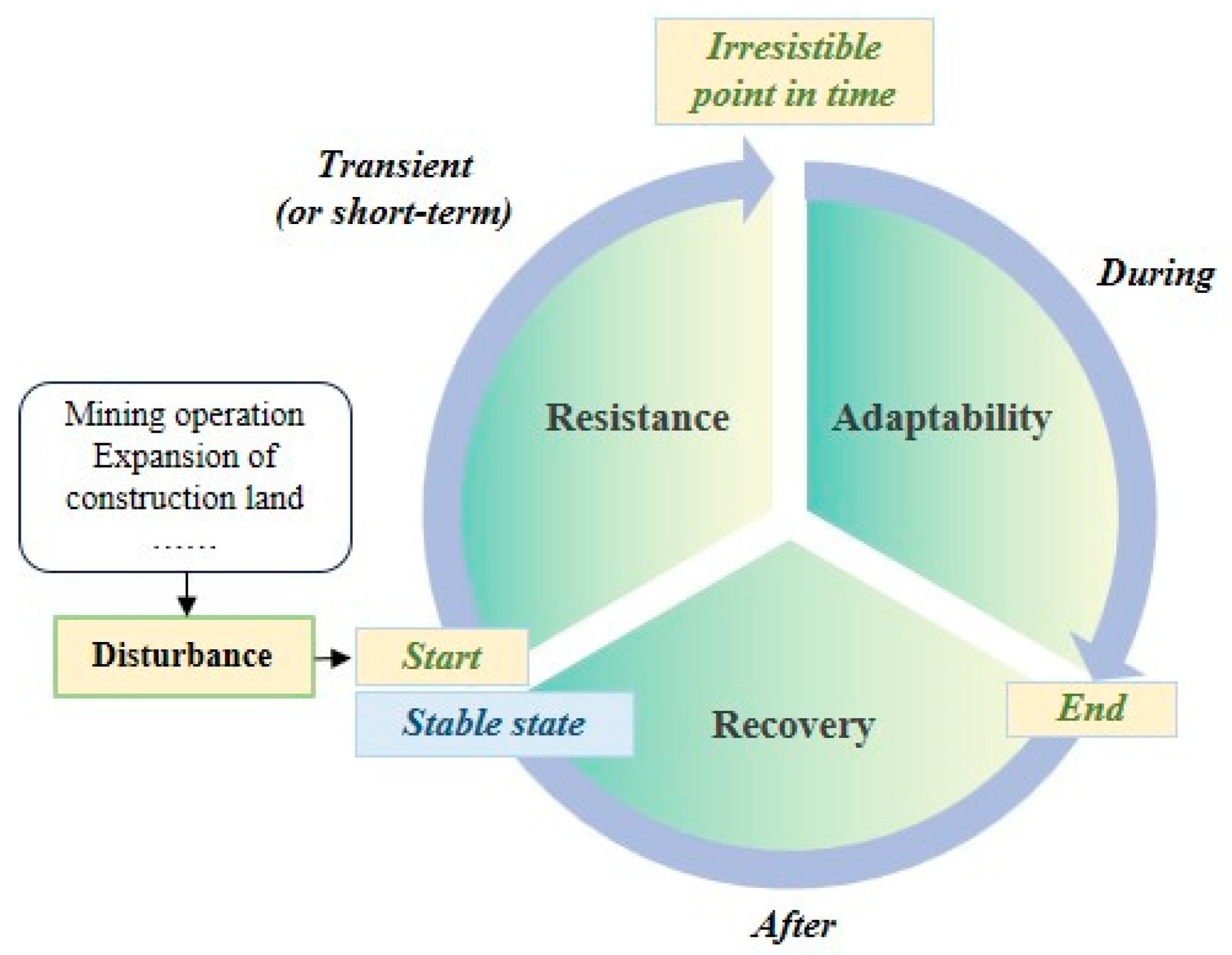
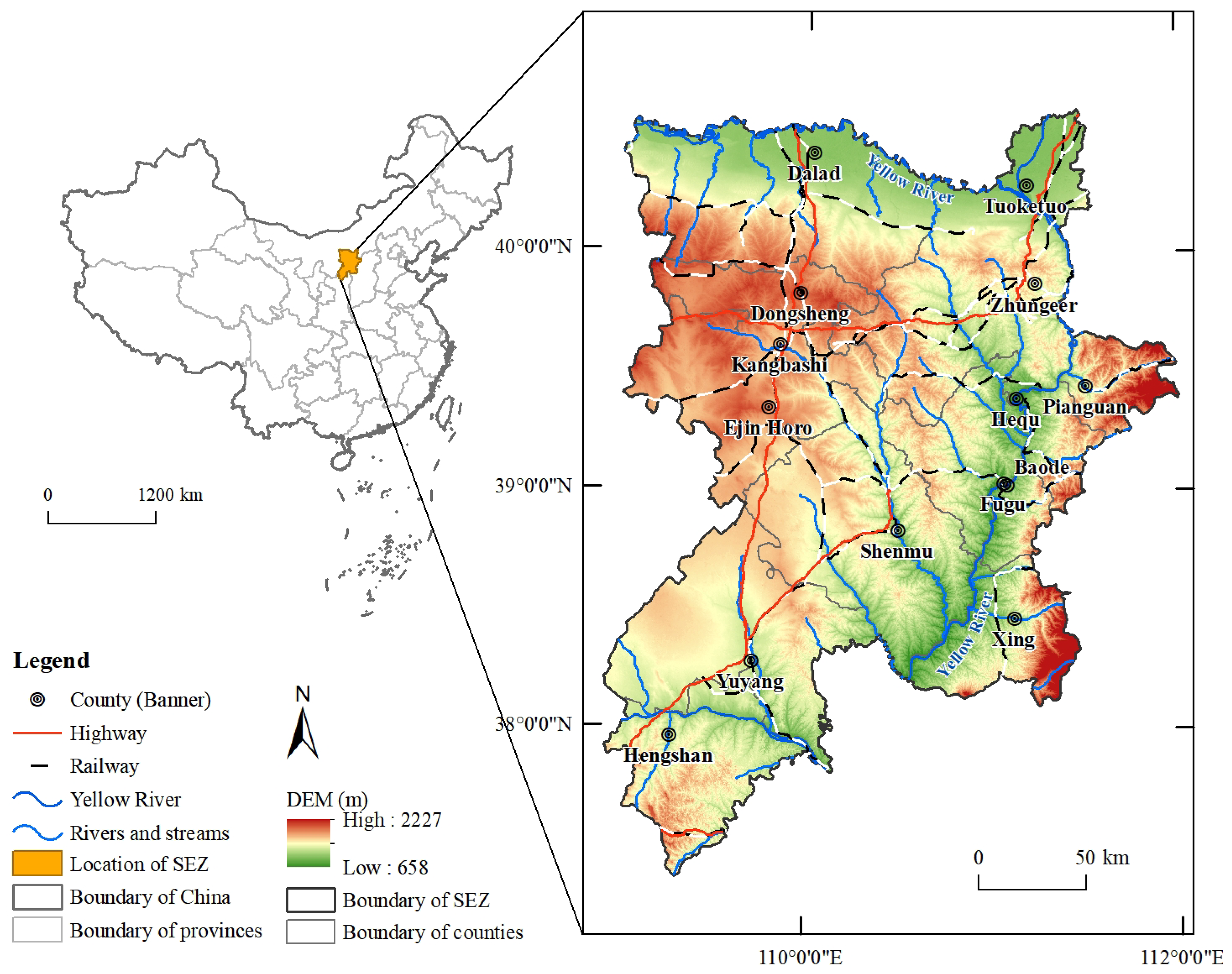
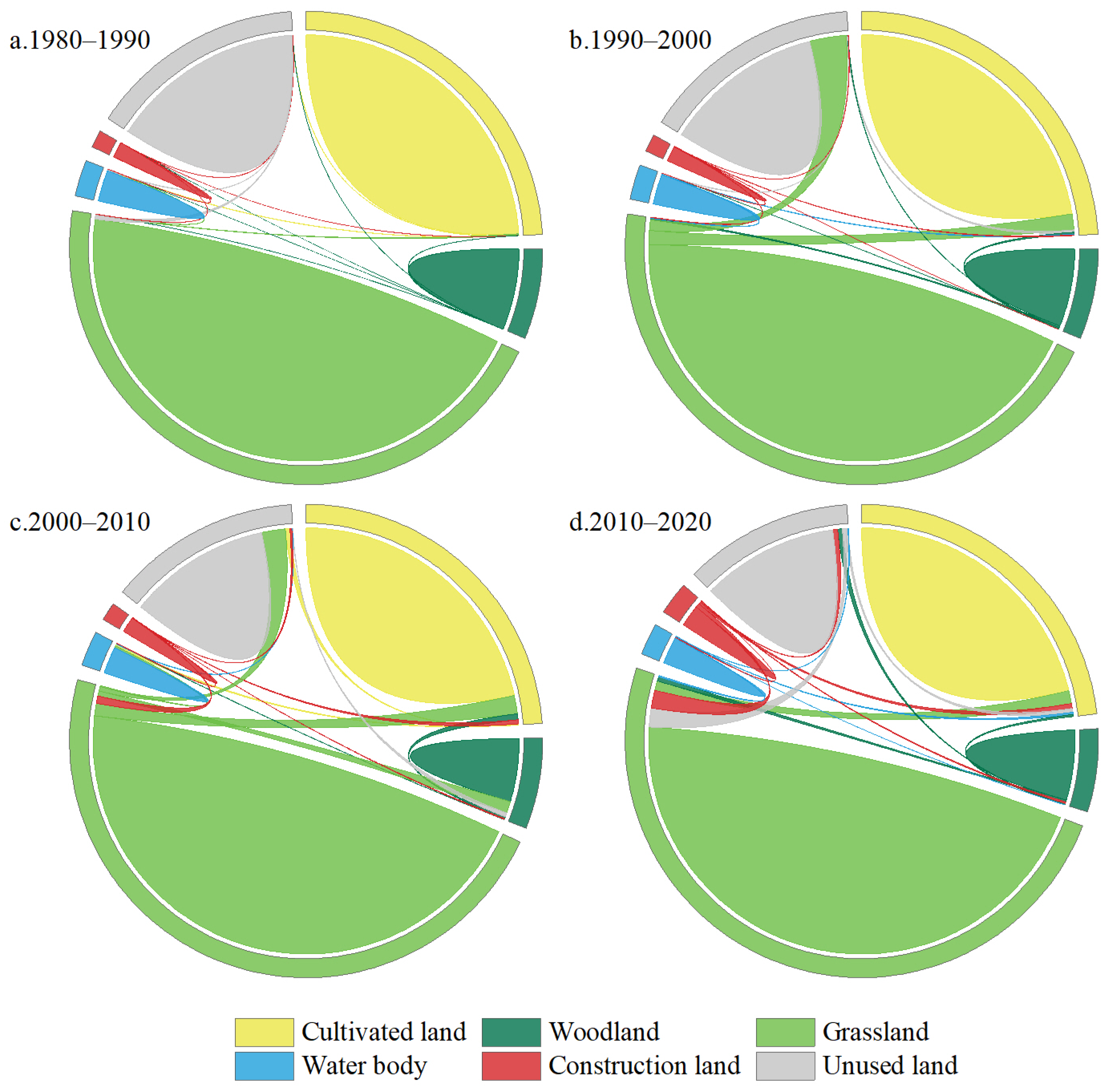

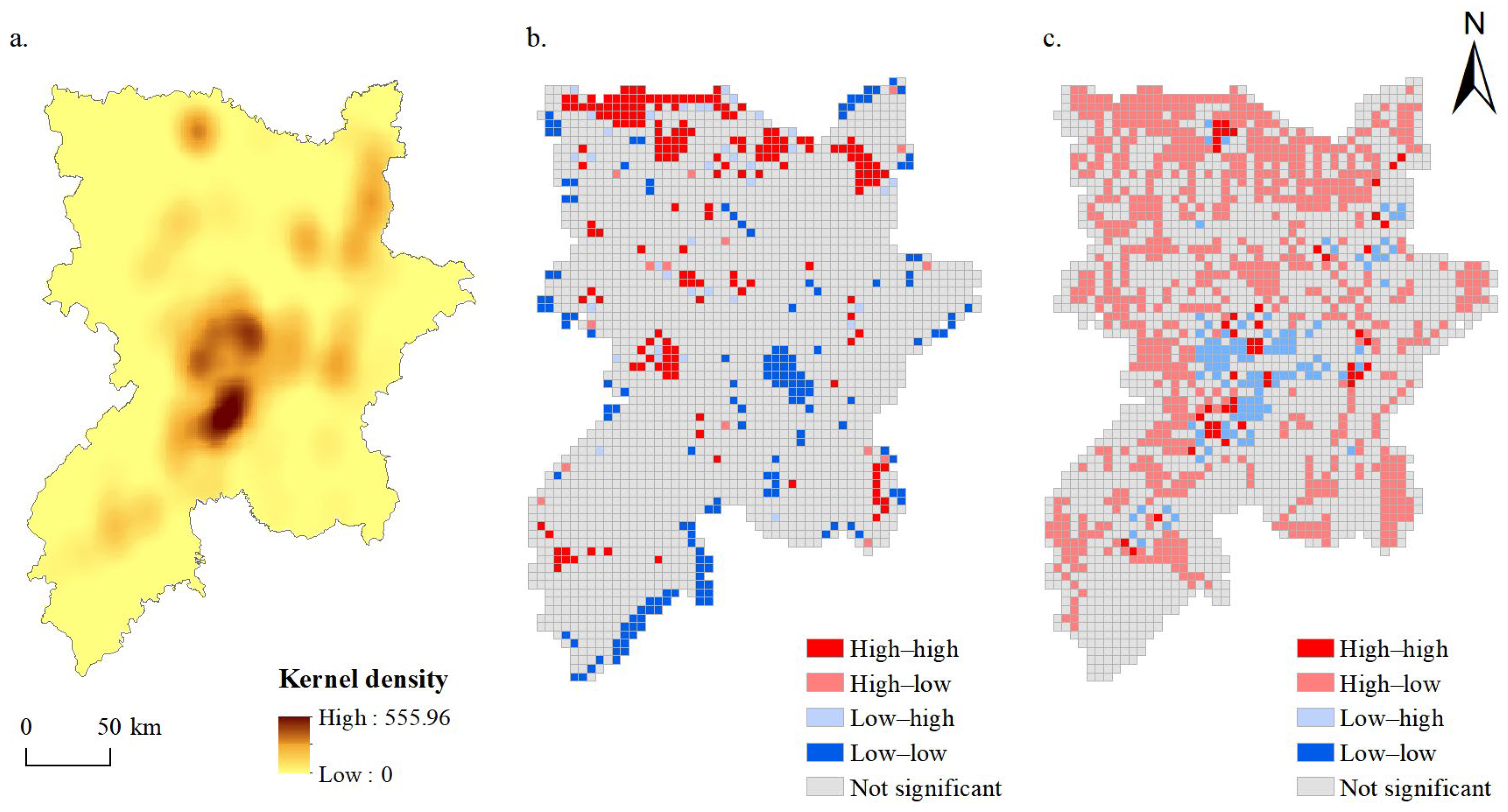

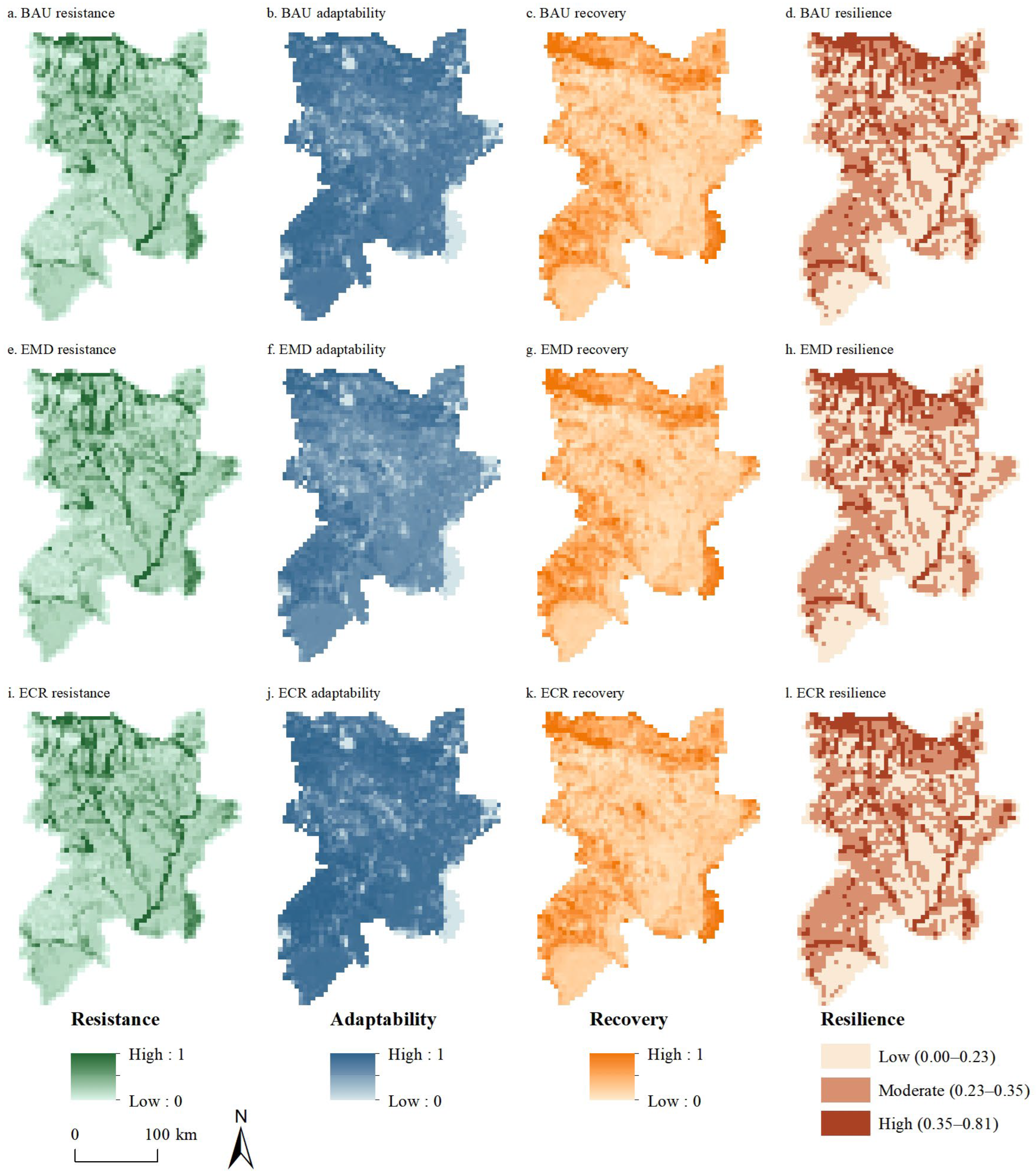

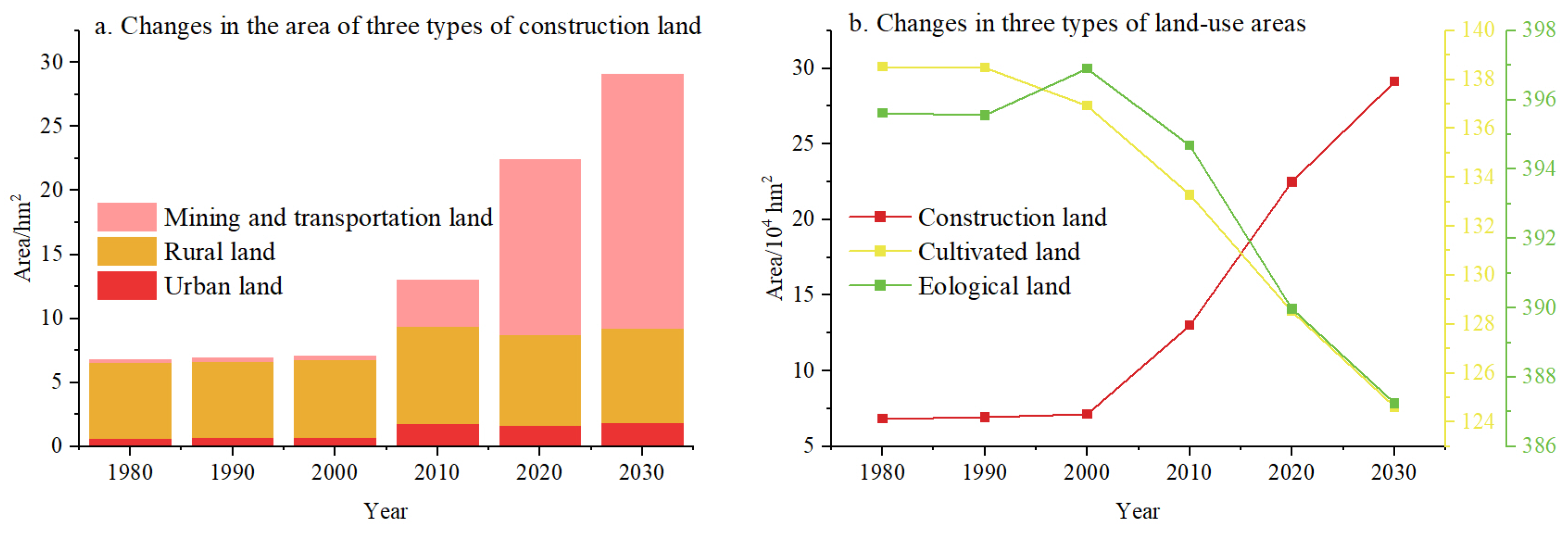
| Category | Data | Years | Spatial Resolution | Data Sources |
|---|---|---|---|---|
| Land-use data | Land use | 1980–2020 | 30 m | CAS (https://www.resdc.cn/, accessed on 19 November 2023) |
| Environmental data | Annual average temperature | 2020 | 1000 m | CAS |
| Annual average precipitation | ||||
| Soil type | - | 30 m | CAS | |
| DEM | 2020 | 30 m | Geospatial Data Source (https://www.gscloud.cn/, accessed on 19 November 2023) | |
| Slope | 2020 | 30 m | Calculated from DEM data in ArcGIS | |
| Socio-economic data | GDP | 2019 | 1000 m | CAS |
| POP | 2019 | 1000 m | CAS | |
| Distance to primary road | 2020 | 30 m | OpenStreetMap (https://www.openstreetmap.org/, accessed on 20 November 2023) | |
| Distance to the secondary road | ||||
| Distance to the tertiary road | ||||
| Distance to railway | ||||
| Distance to highway | ||||
| Distance to open water | ||||
| Distance to county (district/banner) governments | Baidu Maps (https://map.baidu.com/, accessed on 20 November 2023) |
| Ecosystem Services | Ecosystem Sub-Services | Cultivated Land | Woodland | Grassland | Water Body | Construction Land | Unused Land |
|---|---|---|---|---|---|---|---|
| Supply services | Food production | 919.62 | 313.75 | 108.19 | 865.52 | 0 | 0 |
| Raw material production | 432.76 | 714.05 | 151.47 | 248.84 | 0 | 0 | |
| Water supply | 21.64 | 367.85 | 86.55 | 8968.95 | 0 | 0 | |
| Regulation services | Gas regulation | 724.87 | 2347.72 | 551.77 | 833.06 | 0 | 21.64 |
| Climate regulation | 389.48 | 7032.35 | 1449.75 | 2477.55 | 0 | 0 | |
| Environmental purification | 108.19 | 2088.07 | 476.04 | 6004.55 | 0 | 108.19 | |
| Hydrological regulation | 292.11 | 5128.21 | 1060.26 | 110,613.46 | 0 | 32.46 | |
| Support services | Soil conservation | 1114.36 | 2867.04 | 670.78 | 1006.17 | 0 | 21.64 |
| Nutrient cycle maintenance | 129.82 | 216.38 | 54.09 | 75.73 | 0 | 0 | |
| Biodiversity protection | 140.65 | 2607.38 | 605.86 | 2758.85 | 0 | 21.64 | |
| Cultural services | Aesthetic landscape | 64.91 | 1146.81 | 270.48 | 2044.79 | 0 | 10.82 |
| Year | Index | Cultivated Land | Woodland | Grassland | Water Body | Construction Land | Unused Land |
|---|---|---|---|---|---|---|---|
| 1980 | Area (hm2) | 1,385,167.45 | 354,129.67 | 2,607,425.24 | 143,906.9 | 68,390.21 | 850,749.27 |
| 1990 | 1,384,814.49 | 355,127.44 | 2,594,057.03 | 138,313.8 | 69,435.17 | 868,012.62 | |
| 2000 | 1,369,351.74 | 357,458.13 | 2,715,066.99 | 138,911.80 | 71,399.83 | 757,659.37 | |
| 2010 | 1,332,817.65 | 326,925.14 | 2,828,018.35 | 127,356.69 | 130,247.36 | 664,509.28 | |
| 2020 | 1,285,290.65 | 357,009.95 | 2,702,636.34 | 136,160.51 | 224,722.55 | 703,839.01 | |
| 1980–1990 | Variation (hm2) | −352.96 | 997.77 | −13,368.21 | −5593.1 | 1044.96 | 17,263.35 |
| 1990–2000 | −15,462.75 | 2330.69 | 121,009.96 | 598 | 1964.66 | −110,353.25 | |
| 2000–2010 | −36,534.09 | –30,532.99 | 112,951.36 | –11,555.10 | 58,847.52 | –93,150.09 | |
| 2010–2020 | −47,527.00 | 30,084.81 | –125,382.01 | 8803.82 | 94,475.19 | 39,329.73 | |
| 2000–2020 | –84,061.09 | –448.19 | –12,430.65 | –2751.29 | 153,322.72 | –53,820.36 |
| Scenario | Index | Cultivated Land | Woodland | Grassland | Water Body | Construction Land | Unused Land |
|---|---|---|---|---|---|---|---|
| 2020 | Area (hm2) | 1,285,290.65 | 357,009.95 | 2,702,636.34 | 136,160.51 | 224,722.55 | 703,839.01 |
| BAU | 1,248,048.81 | 387,605.88 | 2,599,639.65 | 144,434.97 | 291,278.43 | 738,682.29 | |
| EMD | 1,230,900.15 | 377,966.50 | 2,533,097.43 | 142,015.19 | 321,362.89 | 804,347.85 | |
| ECR | 1,259,151.26 | 400,574.91 | 2,690,466.04 | 147,884.74 | 230,908.65 | 680,704.40 |
Disclaimer/Publisher’s Note: The statements, opinions and data contained in all publications are solely those of the individual author(s) and contributor(s) and not of MDPI and/or the editor(s). MDPI and/or the editor(s) disclaim responsibility for any injury to people or property resulting from any ideas, methods, instructions or products referred to in the content. |
© 2024 by the authors. Licensee MDPI, Basel, Switzerland. This article is an open access article distributed under the terms and conditions of the Creative Commons Attribution (CC BY) license (https://creativecommons.org/licenses/by/4.0/).
Share and Cite
Cai, X.; Song, Y.; Xue, D.; Ma, B.; Liu, X.; Zhang, L. Spatial and Temporal Changes in Ecological Resilience in the Shanxi–Shaanxi–Inner Mongolia Energy Zone with Multi-Scenario Simulation. Land 2024, 13, 425. https://doi.org/10.3390/land13040425
Cai X, Song Y, Xue D, Ma B, Liu X, Zhang L. Spatial and Temporal Changes in Ecological Resilience in the Shanxi–Shaanxi–Inner Mongolia Energy Zone with Multi-Scenario Simulation. Land. 2024; 13(4):425. https://doi.org/10.3390/land13040425
Chicago/Turabian StyleCai, Xinmeng, Yongyong Song, Dongqian Xue, Beibei Ma, Xianfeng Liu, and Liwei Zhang. 2024. "Spatial and Temporal Changes in Ecological Resilience in the Shanxi–Shaanxi–Inner Mongolia Energy Zone with Multi-Scenario Simulation" Land 13, no. 4: 425. https://doi.org/10.3390/land13040425
APA StyleCai, X., Song, Y., Xue, D., Ma, B., Liu, X., & Zhang, L. (2024). Spatial and Temporal Changes in Ecological Resilience in the Shanxi–Shaanxi–Inner Mongolia Energy Zone with Multi-Scenario Simulation. Land, 13(4), 425. https://doi.org/10.3390/land13040425










